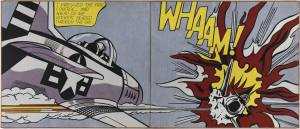What are the key components of Post Modernism ?
The dictionary describes post modernism as a “late 20th-century style and concept in the arts, architecture, and criticism, which represents a departure from modernism and is characterized by the self-conscious use of earlier styles and conventions, a mixing of different artistic styles and media, and a general distrust of theories” The term was first used around 1970. Postmodernism is difficult to define because there is no one theory or idea behind the work. It embraces many different approaches to art making, and many day began with pop art in the 1960s and to embrace much of what followed including conceptual art, neo-expressionism, feminist art. Postmodernism was a reaction against modernism. Modernism was generally based on idealism and a Utopian vision of human life and society and a belief in progress. It assumed that certain ultimate universal principles or truths such as those formulated by religion or science could be used to understand or explain reality.
Roy Lichenstein – Whaam!
Whaam! is based on an image from All American Men of War published by DC comics in 1962. Throughout the 1960s, Lichtenstein frequently drew on commercial art sources such as comic images or advertisements, attracted by the way highly emotional subject matter could be depicted using detached techniques. Transferring this to a painting context, Lichtenstein could present powerfully charged scenes in an impersonal manner, leaving the viewer to decipher meanings for themselves.
What games do you think exemplify this in there design decisions ?
Metal Gear Solid 2 is an example of postmodernism in video game culture using hyperreality and by subverting player expectations in an increasingly over-the-top way. These subversions begin with the game’s marketing within the context of its release. The initial trailers marketed Metal Gear Solid 2 as an epic continuation of Solid Snake’s adventure. That is, until Snake apparently died in the opening. Players take control of Raiden, an often whiny operative, with extensive experience in virtual reality missions but no actual experience in the field of combat. Kojima knew that fans would be infuriated at the realization that they would be controlling the unlikable Raiden for the rest of the game, and deliberately designed the opening sequences of his mission poorly. Raiden’s mission was consistently interrupted by long-winded, unnecessary tutorials.
Raiden was trained as a soldier through virtual reality, playing through simulations of Snake’s previous missions, each of them “indistinguishable from the real thing”. In context, Raiden represents geek culture, he believes that he is qualified for his mission because he played as Snake in combat simulations, lending him a strange inability to grasp the increasingly surreal nature of his adventure. In a closing monologue, Snake asks the player to embrace subjectivity and disregard the search for an objective reality.
Sources
http://www.tate.org.uk/art/art-terms/p/postmodernism
http://www.theartstory.org/definition-postmodernism.htm
https://study.com/academy/lesson/post-modernism-art-definition-theory-characteristics.html
http://tvtropes.org/pmwiki/posts.php?discussion=13312484700A52189400&page=0
http://screwattack.roosterteeth.com/post/51230202
http://www.eurogamer.net/articles/2015-08-16-metal-gear-solid-2-the-first-postmodern-video-game
References
Lebowitz, J. (2011). Interactive Storytelling for Video Games.

